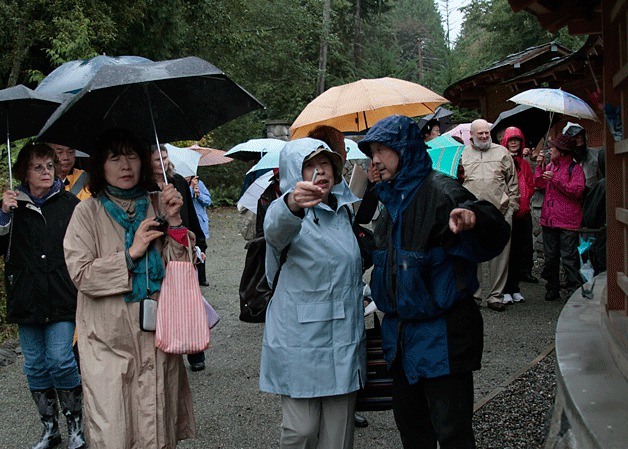“Nidoto Nai Yoni.”
Let it not happen again.
These are the words on the Bainbridge Island Japanese American Exclusion Memorial. They echo the thoughts and memories of the citizens who were forced from their homes in 1942 by President Franklin D. Roosevelt’s Executive Order 9066 and Civilian Exclusion Order No. 1, and the regretful nation that let such a thing happen.
However, these words could just as easily apply to yet another historic tragedy of World War II: the only two nuclear attacks in the history of the world.
The stories of both regrettable episodes came together Saturday, Sept. 28, when a delegation of Japanese hibakusha (atomic bomb survivors) and several others affected by the more recent events at Fukushima from the World Friendship Center came to visit the Bainbridge memorial and met with local citizens who lived through the displacement. Though it is a unique group of representatives within the delegation, this is not the organization’s first such visit to the island.
“This is the third Peace Ambassador trip so far,” said Carol Stern, visit coordinator and delegation host. “It’s a unique group of people who have been involved with peace work for a long time.”
The group consists of four actual atom bomb survivors, children of survivors, translators, one woman displaced by the nuclear disaster in Fukushima, as well as individuals remembering the reconstruction of the cities and discussing the long-reaching effects of radiation exposure.
“This is the first place that Japanese Americans were taken from to the concentration camps during World War II,” explained Clarence Moriwaki, president of the Bainbridge Island Japanese American Exclusion Memorial Association. “More than 120,000 Japanese Americans were taken to the camps from the West Coast. This is a national historic site, designated in 2008.”
On March 30, 1942, 227 Bainbridge Island men, women and children were forcibly removed by Army soldiers, and would become the first mass arrival to the Manzanar “Relocation Center” in California. The memorial, constructed on the site of the old Eagledale Ferry Dock landing site, follows the exact path walked by the displaced citizens to the boat.
Moriwaki went on to explain to the visiting delegation that the memorial is also for the community that later welcomed their neighbors home.
“It also honors the community that looked out for their friends and neighbors and welcomed them home,” he said. “Which was not the case everywhere else.”
The visit to the island is one stop during the delegations larger visit to the United States, including stops in Portland, Seattle and New Mexico.
“It’s been a very rich trip,” Stern said. “They [the delegation] were very impressed with Seattle and the Pacific Northwest.”
While in Seattle, the peace ambassadors were hosted by the Seattle Hiroshima Club and had a chance to meet with their hibakusha.
During the tour of the Bainbridge memorial, the delegation was introduced to Kay Nakao and Lilly Kodama, two island residents who lived through the displacement personally.
The tour of the Bainbridge memorial ended with a stop at the nearby Nipponzan Myohoji Temple where Carol’s husband Michael Stern performed an original song he wrote in memory of the 1942 exile called, “Take Only What You Can Carry.”
There, Moriwaki also shared a very special story from the memorial’s history with the visitors. He recalled for them that during the 60th anniversary of the forced relocation in 2002, there was a ceremony at the memorial at which all 227 names of the displaced were read. As the names were read out, he explained, a group of crows began to gather and make noise. By the end of the list the gathering birds were quite a large group and they were making such a level of noise that it was hard for some in the audience to hear the reading.
When at the end of the list, a moment of silence was called for, and the birds suddenly and uniformly became quiet. For the entire minute they did not make a sound. When the ceremony began again, they flew away.
The visit had a somber but positive vibe, mixing talk of remembrance and honor with the importance of progress and improvement.
“Countries can learn,” Moriwaki said. “Memorials like this teach those lessons.”



